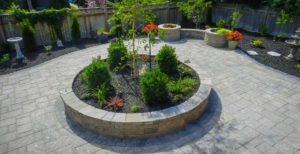 Concrete is a leading building material. It is used worldwide and is popular for its durability and strength. Concrete offers professional landscapers the advantage of being a highly versatile material.
Concrete is a leading building material. It is used worldwide and is popular for its durability and strength. Concrete offers professional landscapers the advantage of being a highly versatile material.
It can be used to enhance outdoor areas since it has unlimited design options with respect to texture, colour and shape.
Moreover, concrete is cost-effective and it’s not as expensive as other materials used for paving. Here are some of the key advantages and shortcomings of choosing concrete for enhancing your landscape.
Reasons for Choosing Concrete for an Outdoor Project
-
Durability
One of the most durable and long lasting building materials is concrete. It is able to endure heavy traffic and extreme climatic conditions. Concrete is also able to resist abrasion from heavy outdoor furniture.
-
Versatility
Concrete is a reliable material for multiple applications in and outside a home. It is regarded as a primary material for building driveways, sidewalks, and patios. Concrete can also be used for making fireplaces, furniture, outdoor waterscapes, sinks, and countertops.
-
Flexibility in Design
Concrete offers multiple design options. You can cast it in unlimited forms or shapes and it is easy to color, dye, stain or stamp concrete.
-
Easy to Maintain
Concrete makes solid surfaces that are easy to clean. It is also easy to maintain and keep concrete surfaces free from weed growth and debris. Regular cleaning and resealing concrete surfaces will always keep them looking attractive for many years to come.
-
Cost Effective
If you compare concrete with other materials used for paving such as natural stone and brick, concrete outshines them in terms of being more economical for it is easier to work with when installing.
Limitations of Using Concrete
A major drawback of using concrete is that it tends to crack as a result of contraction and expansion. However, it is possible to minimize the cracking by installing some control joints during concrete placement.
You should seal concrete surfaces every 2-3 years to prevent it from wearing and staining. Also, concrete installation isn’t a DIY project. If you don’t have the expertise required to deal with concrete, you should hire a concrete expert to handle the project.
Decorative Concrete
Today, concrete no longer looks gray and boring. It is now possible to transform concrete and give it a bright and decorative look using various surface treatments, colors, and textures. For instance, outdoor concrete applications can be stained or stamped, and this is a popular decorative option in many homes.
If concrete will be poured in your new project, you may stamp its surface using a texture of your choice to replicate wood, brick, natural stone, and more. In case you have a concrete structure that you no longer find attractive, you can easily transform it into a more decorative structure by staining it. There are many color choices for staining such as earthy tones to blend well and match with the outdoor environment.
Most homeowners prefer decorative concrete as the best material for their driveway, paths and patios for it gives an elegant look at a very reasonable cost. In case you cannot afford materials like brick or natural stone, then concrete will be the most ideal option to give the same effect.
Contact a decorative concrete expert about the options you have and get some inspiring photos to assist you with the design.